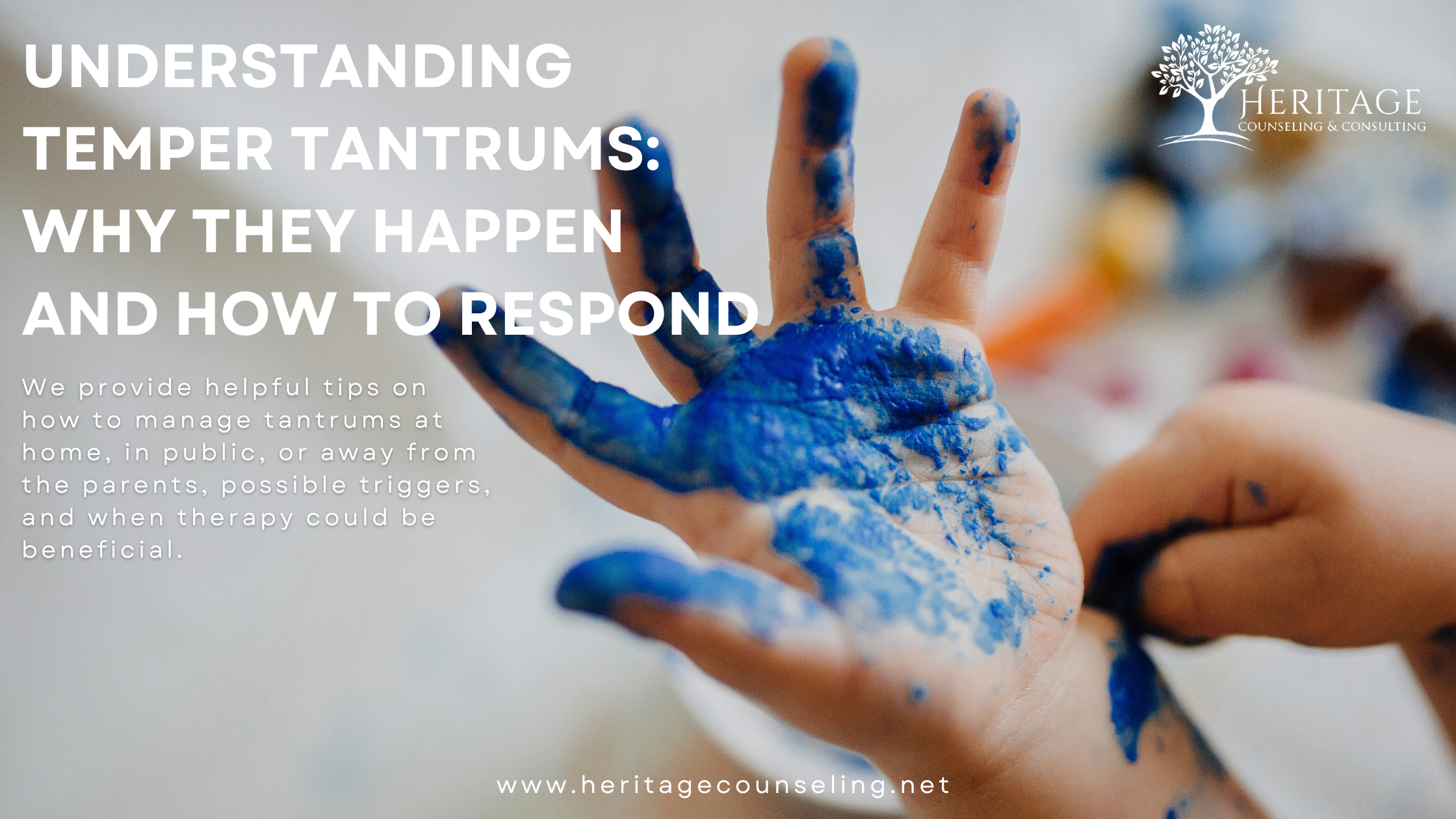Temper tantrums are a common part of childhood development. As young children learn to express their emotions and navigate the world, they often experience frustration, disappointment, or overstimulation, leading to emotional outbursts. For parents and caregivers, it can be overwhelming to witness and respond to these tantrums. Understanding their causes and learning effective ways to respond can help both the child and caregiver navigate these challenging moments with patience and understanding.
What Are Temper Tantrums?
Temper tantrums are sudden emotional outbursts that typically involve crying, yelling, kicking, hitting, or even holding one’s breath. Temper tantrums are often short-lived but can feel intense, both for the child experiencing them and for the parents attempting to manage the situation. Although temper tantrums are most common in toddlers and preschoolers, they can occasionally occur in older children as well.
Young children often lack the ability to regulate their emotions or communicate their needs and frustrations effectively. Therefore, temper tantrums often become a way for them to physically express what they are not able to verbalize. Tantrums can vary in intensity and duration, but they are a normal part of childhood development. As children grow older, acquire language skills, and develop better self-regulation, temper tantrums tend to decrease in both frequency and severity.
Common Instigators of Tantrums
Understanding what triggers a tantrum can empower parents and caregivers to anticipate and manage them effectively. Several factors contribute to the occurrence of tantrums:
Frustration: A common trigger for tantrums is when a child encounters a task or situation that exceeds their abilities, leading to frustration. For example, when a child struggles with a puzzle that is too complex for their developmental stage, the frustration can quickly escalate into a tantrum.
Fatigue: Lack of sleep is a significant factor in increased irritability. When children do not get enough quality rest, they can become emotionally heightened, making them more prone to outbursts.
Hunger: A hungry child is often an impatient and emotional one. When children are hungry, they may not be able to communicate their needs effectively, and the discomfort can result in a tantrum.
Overstimulation: Environments that are too loud, crowded, or busy can overwhelm young children. Overstimulated children may struggle to process the varying degrees of input they are trying to receive, which can lead to a tantrum.
Desire for Independence: As children grow, they begin to assert their independence. When their autonomy is restricted or they feel they are being treated unfairly, they may throw a tantrum as a way of expressing frustration over their limited ability to make decisions for themselves.
Difficulty Expressing Emotions: Young children often have limited language skills, making it difficult for them to articulate how they feel. The inability to express themselves effectively can lead to emotional outbursts.
How to Handle Tantrums at Home
When a tantrum occurs at home, it is important to remain calm and respond in a way that helps the child regain control. Here are some effective strategies:
Stay Calm: Your child looks to you for cues on how to handle emotions. If you respond with frustration or anger, it can escalate the situation. Instead, remain composed. This helps de-escalate the situation and allows your child to mirror your emotional cues.
Acknowledge Feelings: Validating your child’s emotions helps them to feel heard and understood. Phrases like, “I see you’re frustrated because you wanted to play with that toy,” let your child know their feelings are valid, even if their actions are not appropriate. To assist your child in their emotional development, work with them to identify and label the specific emotion they are feeling.
Provide Comfort or Space: Some children may want a hug to feel safe and loved, while others might need space to calm down. Pay attention to your child’s cues and respond accordingly. Prompt them with two acceptable options if and when appropriate.
Redirect Attention: If possible, gently direct your child’s attention to a different activity or item. Sometimes, a simple shift in focus can stop the tantrum from escalating.
Teach Emotional Regulation: While your child is calm, work with them on regulation techniques such as deep breathing, counting to ten, singing a song, or using words to express their feelings. Practicing techniques when calm helps your child to more effectively utilize them when emotions run high.
Set Clear and Consistent Boundaries: Establishing clear rules and expectations can help children understand what behavior is acceptable. Consistency in enforcing boundaries helps them feel secure and reduces confusion.
Managing Tantrums in Public
Public tantrums can be particularly stressful, but handling them effectively can minimize embarrassment and frustration.
Stay Calm and Avoid Escalation: It can be easy to feel embarrassed or fed-up when a tantrum occurs in public. Responding with anger, however, can escalate the situation. Stay calm, speak gently, and avoid raising your voice or using bribes to alter your child’s behavior.
Remove Triggers: If the tantrum is due to overstimulation, try moving to a quieter space. Sometimes, simply changing environments can help calm a child down. For example, a corner of a store or a quiet bench outside can serve as a neutral space for both of you to destress and regulate.
Use Distractions: Sometimes, engaging your child with a different activity or pointing out something interesting nearby can help redirect their focus and interrupt the tantrum cycle. If you are at the store and your child is upset about not getting a toy, ask them to help choose which fruit the family should get for breakfast.
Be Prepared: When out and about, ensure you have comfort items such as snacks, water, or a favorite toy on hand. Sometimes a small snack or a familiar item can soothe a child during a stressful moment. Tip: keep a small bag with calming items like a stuffed animal or blanket in your car to help your child feel more secure.
Follow Through: If you set expectations before leaving (e.g., “We’re not buying a toy today”), stand by your decision to reinforce boundaries. Be firm but gentle when explaining why you cannot give in to their requests. Explain your reasoning in a way that they can understand, like, “We are here to get groceries, not toys today.”
Addressing Tantrums When You’re Not Present
Sometimes, tantrums occur when your child is at daycare, school, or a friend’s house. In these cases, open communication with caregivers is key.
Discuss Triggers with Caregivers: Share insights on what typically sets off your child’s tantrums, such as hunger or frustration, so caregivers can be proactive. Provide them with strategies that work best for your child. Keep an open line of communication with teachers, daycare providers, and caregivers and check in with them periodically. Ask them to update you if they notice patterns in your child’s behavior.
Teach Self-Regulation Skills: Encourage your child to use simple techniques like taking deep breaths or counting to ten to calm themselves. These techniques can be practiced and utilized both at home and in other settings. Provide caregivers with simple strategies, such as using a visual cue like a “calm-down jar” filled with glitter, which your child can shake when they need to self-soothe.
Establish a Consistent Routine: Predictability can help children feel secure and reduce the likelihood of tantrums. A consistent routine allows children to know what to expect, minimizing anxiety and frustration. Work with caregivers to create a consistent daily routine, especially for transitions between activities like lunch, nap time, or playtime.
Follow Up with Your Child: If a tantrum occurs while you’re away, take time to discuss it with your child afterward. Help them process their emotions and guide them toward understanding what happened. Ask your child, “What made you upset today?” and explore the emotions together. Praise them for using calm-down strategies when possible.
The Role of Therapy in Managing Tantrums
For some children, frequent or intense tantrums may indicate deeper emotional or developmental concerns. Therapy, particularly play therapy, can be a valuable tool in helping children develop emotional regulation skills.
Play Therapy: This child-centered approach allows children to express their emotions, thoughts, and concerns through play. Since young children often lack the verbal skills to articulate complex emotions, this form of therapy allows them to communicate and process their feelings in a developmentally appropriate way. Through play, your child may reenact situations that reflect their internal struggles or fears, providing therapists with insight into potential causes of tantrums. This therapy is especially useful for younger children who may not have developed sufficient emotional vocabulary, or for kids who find it difficult to articulate what is bothering them. Play therapy can also help children develop coping strategies and deepen their emotional intelligence.
Parent Coaching: Parent coaching focuses on equipping parents with specific strategies and tools to manage their child’s tantrums at home and in other settings. This approach is typically recommended when tantrums are frequently disrupting the child’s home or school life. A therapist can work with parents to understand the child’s needs, triggers, and emotional patterns–helping them recognize the signs of escalating emotions before they result in a tantrum. Parent coaching can be beneficial for parents who feel overwhelmed or unsure about how to respond to their child’s outbursts. By providing consistent strategies and offering a deeper understanding of their child’s behaviors, parents can create a more structured, supportive environment that reduces tantrums and promotes emotional regulation.
Emotional Support: A combination of play therapy and parent coaching is often most helpful in providing families with emotional support. Therapy can help both children and parents work through underlying stressors or traumas that may be contributing to frequent or intense tantrums. Children may experience tantrums as a response to difficult emotions such as anxiety, sadness, or frustration, often stemming from various life events (e.g., relocation, divorce, bullying, peer challenges). In these cases, therapy can provide a safe space for the child to process their emotions and begin to better understand the connection between their feelings and their behaviors. By addressing these deeper issues, therapy can help both children and parents gain greater emotional awareness and build resilience, leading to longer-term improvements in emotional regulation.
At Heritage Counseling & Consulting, we provide specialized therapy services to support children and families navigating emotional and behavioral challenges. If you’re struggling with managing your child’s tantrums, our expert therapists can provide guidance and support tailored to your family’s needs.
To learn more or schedule an appointment, contact Heritage Counseling today at 214-363-2345. Let’s work together to help your child build emotional resilience and confidence.

